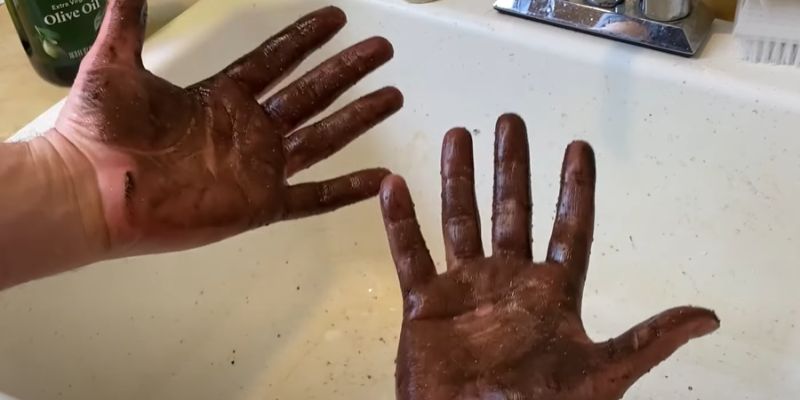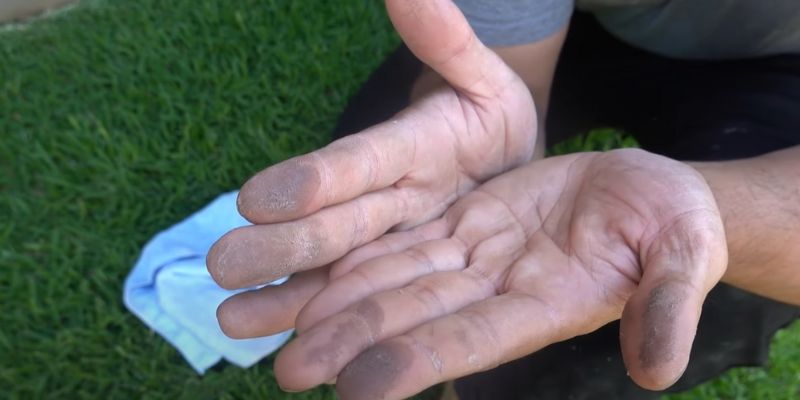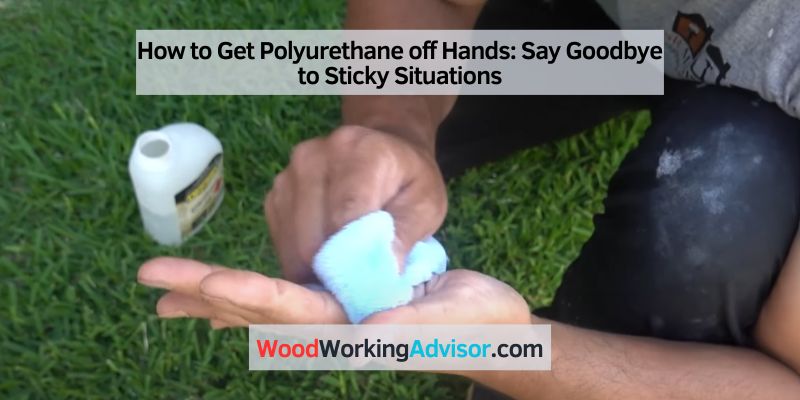To remove polyurethane from hands, use warm soapy water and scrub thoroughly. Polyurethane can be difficult to remove from hands, especially once it dries.
However, by following a few simple steps, you can effectively get rid of it. This article will provide you with a handy guide on how to remove polyurethane from hands. Whether you accidentally got it on your hands while working with a polyurethane-based product or you’re trying to clean up after a messy project, these tips will help you remove the stubborn residue.
From using warm soapy water to employing household items like vinegar or nail polish remover, you’ll find different methods to suit your needs. Say goodbye to sticky hands for good with these effective techniques.

Methods To Remove Polyurethane
Discover effective methods to remove polyurethane from your hands without any hassle. Say goodbye to sticky residues with these simple techniques.
Polyurethane can be a tough substance to get off your hands once it dries. Thankfully, there are several effective methods you can try to remove polyurethane. In this article, we will explore three primary methods to get rid of polyurethane residue: using soap and water, using household items, and trying a commercial hand cleaner. Read on to find out how to free your hands from stubborn polyurethane stains.
1. Use soap and water
One of the simplest and most accessible methods for removing polyurethane from your hands is using soap and water. Follow these steps to effectively clean your hands:
- Wet your hands with warm water.
- Apply a generous amount of dish soap or any mild hand soap to your hands.
- Rub your hands together vigorously, focusing on the areas with polyurethane residue.
- Rinse your hands thoroughly with warm water, ensuring all soap and polyurethane residue is washed away.
- Pat your hands dry with a clean towel.
Using soap and water is an excellent first step in removing polyurethane from your hands, as it is readily available in most households.
2. Use household items
If soap and water do not completely eliminate the polyurethane residue, you can try using common household items to aid in the removal process. Here are a few potential options:
- Vegetable oil: Apply a small amount of vegetable oil to the affected areas and gently massage it into your skin. Let it sit for a few minutes, then use soap and water to wash your hands.
- Warm vinegar: Soak a clean cloth in warm vinegar and scrub the polyurethane-covered areas. The acidity of the vinegar helps break down the residue. Rinse your hands with soap and water afterwards.
- Nail polish remover: Ensure the nail polish remover contains acetone. Dampen a cloth or cotton ball with the remover, and gently rub the affected areas. Wash your hands thoroughly with soap and water afterwards.
Remember to test these household items on a small patch of skin before applying them to your entire hands to avoid potential allergic reactions.
3. Try commercial hand cleaner
If the previous methods do not succeed in completely removing the polyurethane, you can opt for a commercial hand cleaner. These products are specifically designed to tackle stubborn substances like polyurethane. Follow these steps for effective use:
- Read the instructions and safety precautions provided on the commercial hand cleaner.
- Apply the hand cleaner to your hands, focusing on the areas with polyurethane residue.
- Gently massage the cleaner into your skin, ensuring complete coverage of the affected areas.
- Rinse your hands thoroughly with warm water, removing all traces of the hand cleaner and polyurethane residue.
- Dry your hands with a clean towel.
Commercial hand cleaners are widely available and can be found at hardware stores, automotive retailers, or online.
Removing polyurethane from your hands can be a bit challenging, but with these methods, you can successfully get rid of the stubborn residue. Whether you choose to use soap and water, household items, or a commercial hand cleaner, you can restore your hands to their natural state and continue with your projects without worry.
Tips And Precautions
Discover effective tips and precautions for removing polyurethane off hands easily and safely. Learn how to protect your skin and avoid any potential harm caused by this strong adhesive.
Prevention Is Better Than Cure
It is always better to prevent getting polyurethane on your hands in the first place. Taking the necessary precautions can save you from the hassle of trying to remove it later. Here are some simple tips to help you prevent getting polyurethane on your hands:
- Wear protective gloves before handling polyurethane. Choose gloves that are resistant to chemicals.
- Wear long-sleeved shirts and pants to minimize skin exposure.
- Cover your hair with a hat or hairnet to avoid polyurethane getting in your hair.
- Use a brush with a long handle to apply polyurethane, ensuring it stays away from your hands as much as possible.
Test Products On A Small Area First
It is essential to test any products you plan to use for removing polyurethane on a small, inconspicuous area of your skin first. This helps ensure that you don’t have any adverse reactions or allergies to the product. Here’s how to do it:
- Apply a small amount of the product on a small patch of skin, such as the back of your hand.
- Wait for at least 24 hours to see if any itching, redness, or irritation occurs.
- If there are no adverse reactions, you can proceed to use the product to remove the polyurethane from your hands.
Seek Medical Attention If Necessary
In some cases, removing polyurethane from your hands may require more than just simple home remedies. If you experience any of the following, it is important to seek medical attention:
- Severe skin irritation or burning sensation that persists despite home treatments.
- Allergic reactions, such as difficulty breathing, swelling, or hives.
- Ingestion of polyurethane or exposure to eyes, ears, or other sensitive areas.
Remember, when it comes to your health, it’s always better to be safe than sorry. Seeking medical attention can ensure proper care and treatment if the situation calls for it.

Frequently Asked Questions Of How To Get Polyurethane Off Hands
How Do You Clean Polyurethane Off Your Hands?
To remove polyurethane from your hands, wash them immediately with soap and warm water. Scrub gently to remove the residue. If the polyurethane has dried, use a mixture of dish soap and vinegar to loosen it. Rinse thoroughly and moisturize your hands afterwards.
What Removes Dried Polyurethane?
To remove dried polyurethane, use a sanding technique. Gently sand the surface using fine-grit sandpaper until the polyurethane is completely removed.
What Dissolves Polyurethane Adhesive?
Polyurethane adhesive can be dissolved using acetone or a mixture of isopropyl alcohol and water. These solvents effectively break down the adhesive, making it easier to remove. Remember to work in a well-ventilated area and follow safety precautions when using solvents.
How Do You Clean Up Spilled Polyurethane?
To clean up spilled polyurethane, follow these steps:
1. Absorb as much of the spill as possible using absorbent material.
2. Wipe the area with a cloth soaked in mineral spirits.
3. Scrub gently with a soft brush to remove any remaining residue.
4. Rinse the area with warm soapy water.
5. Dispose of any used materials properly.
Conclusion
It is important to act quickly when attempting to remove polyurethane from your hands. By using simple household items such as soap, water, and oil, you can effectively remove the sticky residue without causing further damage. Remember to thoroughly rinse your hands and moisturize afterward to rehydrate the skin.
With these easy steps, you can say goodbye to polyurethane stains and enjoy clean, smooth hands once again.


